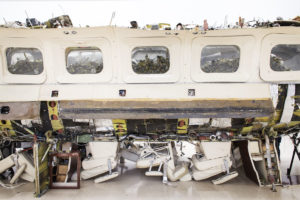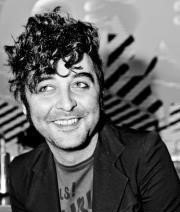In the 70s Gordon Matta-Clark, after meeting Robert Smithson who introduced him to the Land Art, moved to New York to take part in the artistic and cultural ferment of the most lively city of the moment. Attracted by organic materials and their transformations (in one of his first performances he roasts a pig and serves it to the public) the artist founded Food, a restaurant-meeting place for artists and creative people. In 1973 his irreducible language took shape: together with Laurie Anderson, Richard Nonas, Lucio Pozzi and other artists, Gordon founded Anarchitecture, a movement that overturns the traditional idea of architecture. Gordon identifies abandoned buildings or buildings destined for demolition and intervenes in the architectural structure, creating cuts, gashes and cracks that reshape space and identity. In Splitting (1974) an entire house is divided in half by a vertical cut; in Conical Intersect (1975), on the occasion of the Paris Biennial, two buildings are drilled before their final dismantling to leave place for the Center Pompidou. These structural interventions, called “building cuts”, challenge the idea of space, of exterior and interior, of light and shadow, but they are also political acts of protest against the American building exploitation of the Seventies. Gordon Matta-Clark dies in 1978, only thirty-five years old, due to pancreatic cancer and his radical approach is handed over to the history of art still incorrupt and powerful, before the system and the critics could metabolize it.
From here the work of Roman Stańczak ideally starts again, who in the Poland Pavilion in the 58th International Art Exhibition – La Biennale di Venezia presents an impressive environmental installation, entitled The Flight. For the occasion, the artist transforms the exhibition space into a hangar at the center of which there is a real plane overturned so that the interior, ie the elements of the cockpit, the cabin and the passenger seats, are visible on the outside, while the wings and the planking are compressed and rolled up inside the sculpture. The visitor finds himself displaced in front of the paradoxical monumentality of the object and is instigated to investigate its interior with an almost voyeuristic attitude. The alienation gives way to desire but after the initial and morbid attraction for the disaster, arrives a more analytical attention for the intricate routes of the cables left in the open, for the seats still soft tipped over and curled up in a fetal position, for the imperfect sutures that support the whole, for the scratches and the marks that can be glimpsed in the rolled wings. It is clear how weak the boundary between safety and danger is, how uncertain the established order is and it is also discovered with a certain discomfort that the innards of that gutted mechanical carcass can disturbingly resemble the ducts that guarantee the functioning of a biological body.
The artist’s interest is profoundly humanist, for him it is important that the objects he destroys to reshape have met the man and bear the memory of his body and his gestures. In The Flight this suggestion becomes choral and universal: the plane has transported hundreds of people at high altitude and in its interstices birds and wasps have found refuge, whose nests have been incorporated into the work as an integral part of the machine. Through worn and brutalized everyday materials, Roman Stańczak speaks of the ancestral human yearning to go beyond the material world to access the spiritual dimension, recounts his aptitude to inhabit the matter and his inability to definitively free himself from it. It speaks of the limit and the beauty of imperfections, which are perhaps much more compelling than the aseptic perfections of functional and efficient forms, and of the irreducible unpredictability of life.
His working method takes on performative and almost ritual connotations: sculpting is for him a close encounter with an object to be confronted in a violent melee and when the object is the size of The Flight‘s plane, the fight becomes titanic. Stańczak has in fact cut the fuselage lengthwise in a single cut to overturn it as if it were the skin of an animal and suture it again by replacing its innards on the outside. The plane is open like a prey and the internal structures show their elasticity: the vulnerability of the new structure recalls to the artist that of a piece of meat to be roasted, in singular similarity with the first performance of Matta-Clark. Here too the different reformulation of space and light leads to an almost sacral exploration of the object that loses its pre-established function to become a pure signifying form. Another aspect in common between the two artists is the great scale of a work that goes beyond the measure of the human body and that for this magnifies the demiurgic potential of its gesture. For Stańczak, creating is a way of testing himself and his dormant abilities by expanding his possibilities to ideally reunite with the ancients who managed to move enormous stones to build architectures at the limit of the incredible. The essence of sculpture is to be found in the effort of the body which strengthens the mind and sublimates the thought.
Destruction, the prelude of a new creature, thus becomes a symbol of strength and awakens the utopia of uniting a divided society starting from the recognition of its weaknesses and the inevitability of transformation. Sculpture is an invitation to abandon false security and rigid identities, to take the risk of dissolving in the world to be reborn in new free and inclusive forms and then (perhaps) finally fly.
Info:
 Roman Stańczak at work on the sculpture Flight, film still from Anna Zakrzewska’s and Łukasz Ronduda’s film Flight, 2019, Kijora Film
Roman Stańczak at work on the sculpture Flight, film still from Anna Zakrzewska’s and Łukasz Ronduda’s film Flight, 2019, Kijora Film



For the last three images: Pavilion of POLAND, Flight.
58th International Art Exhibition – La Biennale di Venezia, MayYou Live In Interesting Times
Photo by: Francesco Galli Courtesy: La Biennale di Venezia

Actor and performer, he loves visual arts in all their manifestations.






NO COMMENT